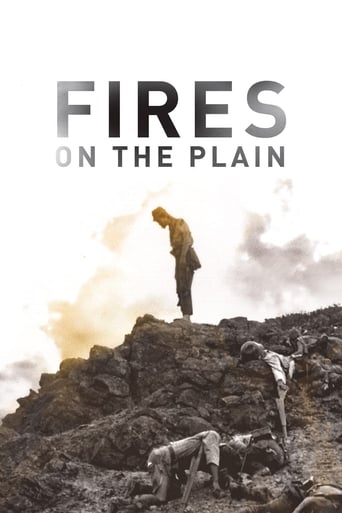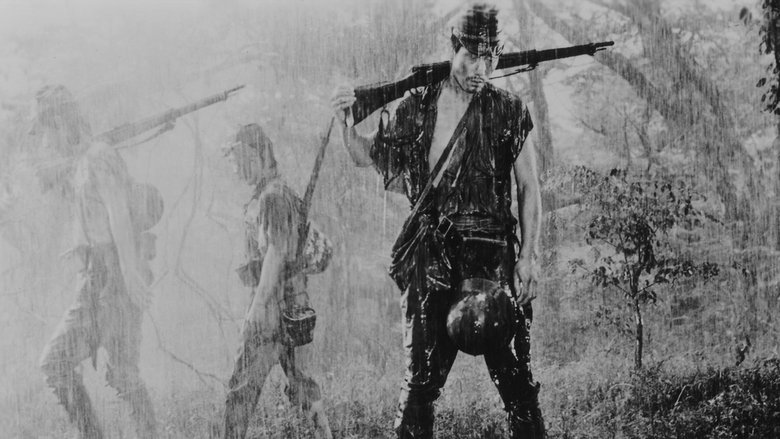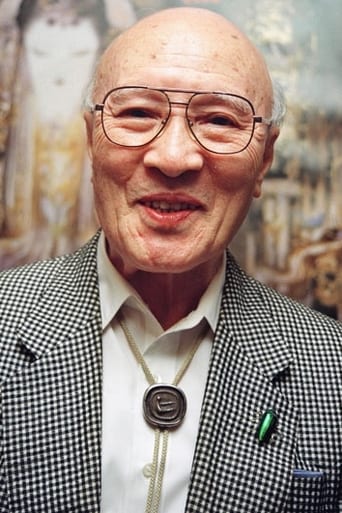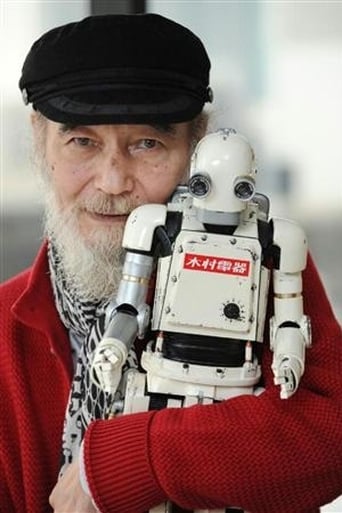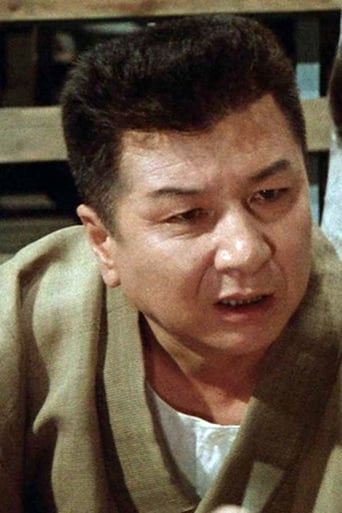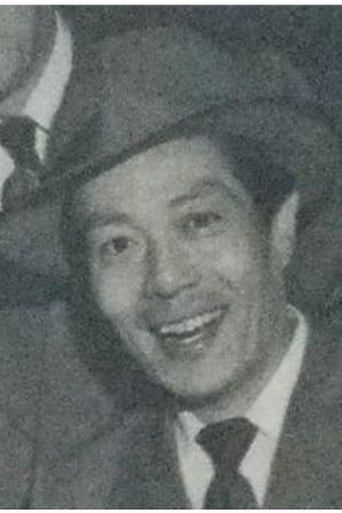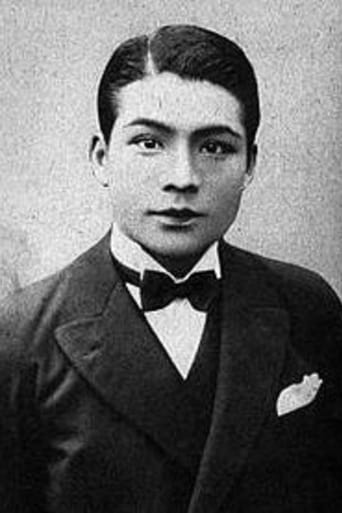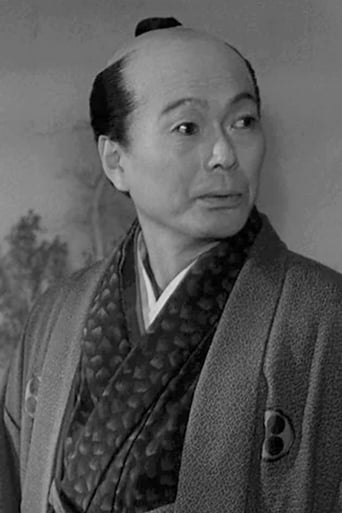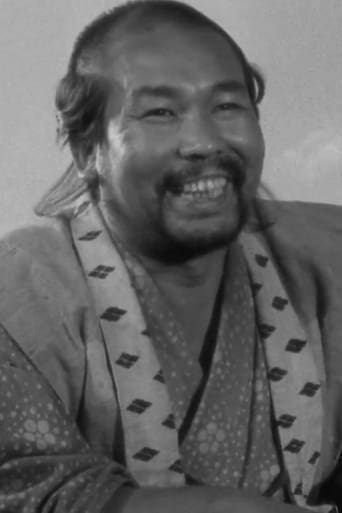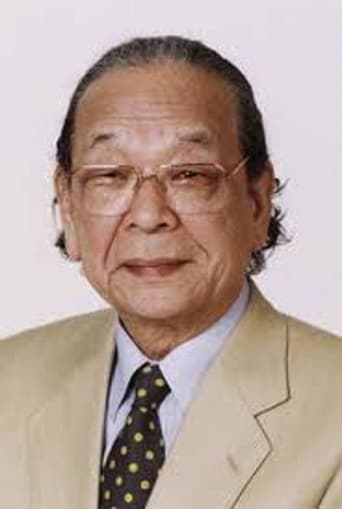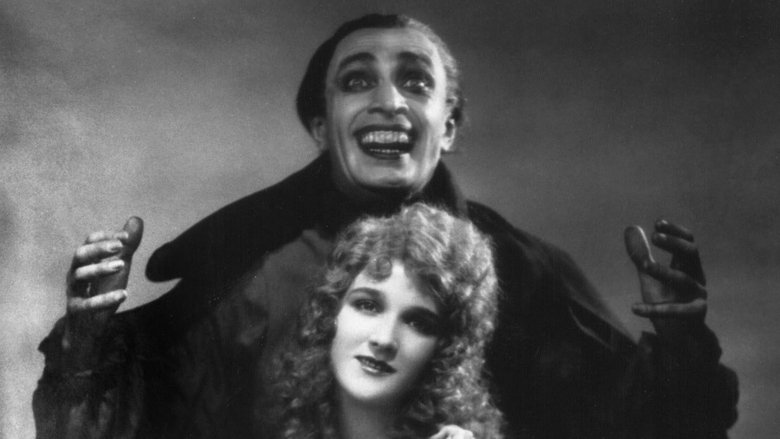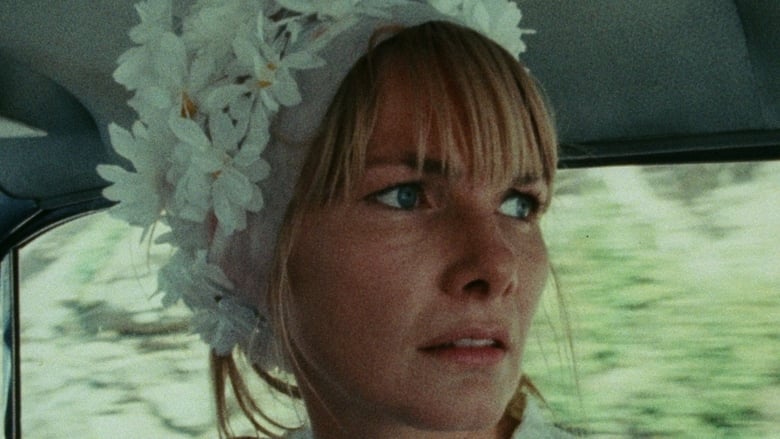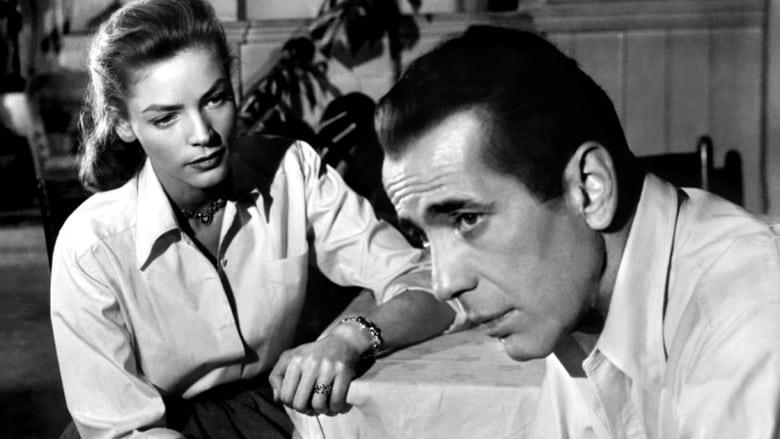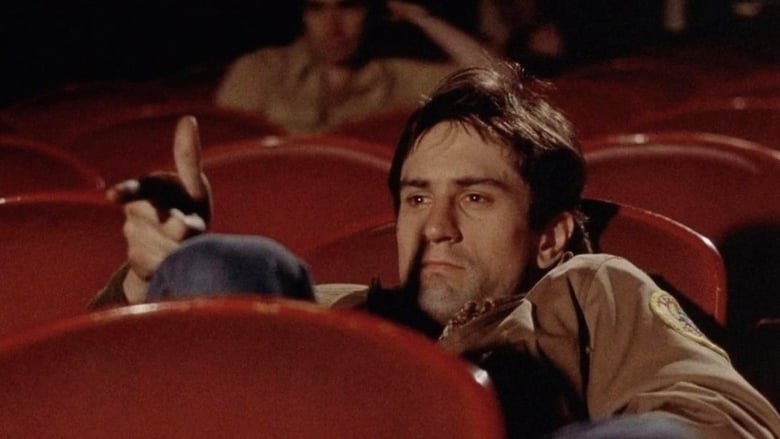In the closing days of WWII, a Japanese soldier afflicted with tuberculosis is abandoned by his company and left to wander the Philippine island of Leyte.


Similar titles
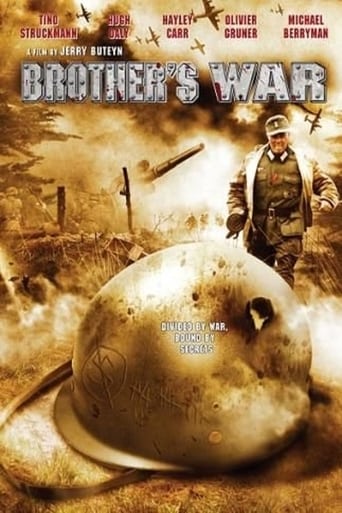

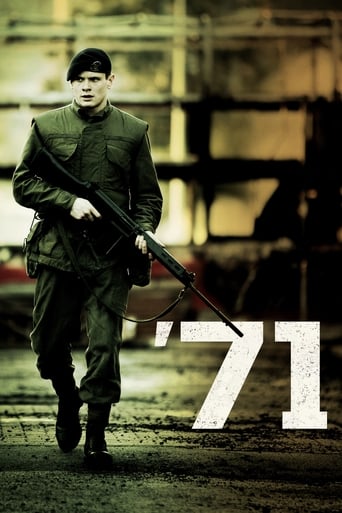
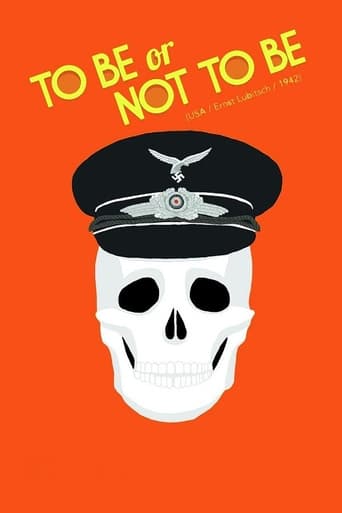
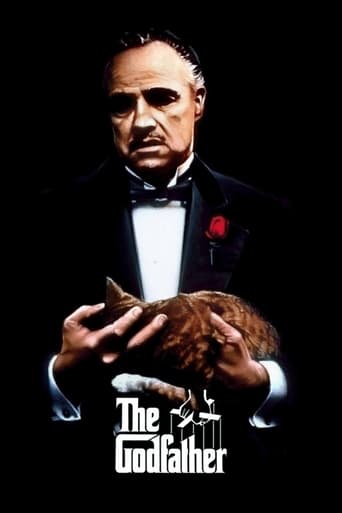
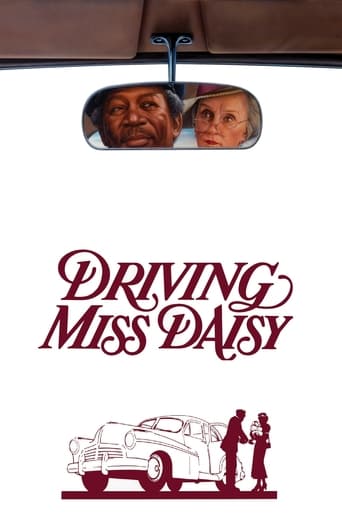
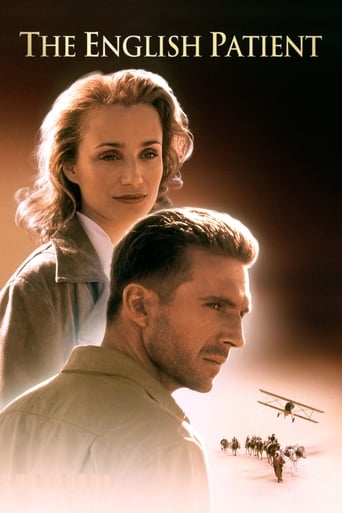


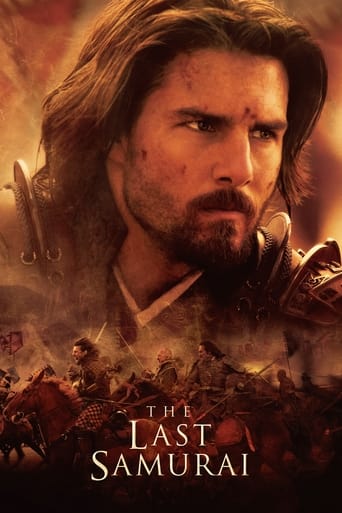
Reviews
Yet again, I appear to be the only person on planet Earth who is capable of criticizing Japanese films made before 1970. "Fires on the Plain" (1959) is another in the seemingly endless line of "classics" that get all sorts of praise for no apparently good reason. As much as I love to overgeneralize and psychoanalyze all of these moviegoers who have such horrible taste in film, it's still nearly impossible to rationalize why anyone would ever think that poorly made fluff like this should be proclaimed as some sort of "masterpiece." What I find truly ironic is that fans of derivative "classics" like "Fires on the Plain" focus so much on "inside the box" movie-making (orthodox grading standards like scriptwriting, acting, camera-work, etc.) yet it always seems like the most highly revered "classics" are most deficient in these very standards. For example, one of the laziest copouts for a filmmaker involves forced verbal exposition where characters basically explain everything for the viewer even when the constructed scenario is totally artificial. Most surprisingly, the very first scene in "Fires on the Plain" uses this indolent tactic to the extreme.After a funny head slap, the following useless dialogue assaults the viewer, "Why can't you grasp the situation? We landed to the west under heavy fire to reinforce units at Tacloban. We lost two-thirds of our men. Our artillery was sunk in transit. We tried to reach Burauen airfield by crossing the central mountains but without artillery it was impossible. The enemy's counterattack forced a fanout across the valley. You know that." So why, exactly, is one character telling another character something he already knows? Oh yeah, that's right, the makers of this film are too lazy to think of more natural ways to communicate this information. You see, a quality film would actually show these events happening, or at worst it would involve dialogue involving one character who has no knowledge of those events. Heck, even an opening summary in paragraph form directed at the viewer would have been better than what transpired here.Such instances of poor quality movie-making are littered throughout "Fires on the Plain" to the point where this film feels like it was written by imbeciles for imbeciles. For example, the lead character stumbles upon some skeletons wrapped in Japanese garb. Instead of doing the natural thing like – oh I don't know – giving a depressed mannerism, the character blurts out "Japanese soldiers." Thanks buddy, but I could have figured that one out for myself.Even worse, this movie is saturated with over-dramatic ploys. The most ridiculous scene involves a pair of boots. Picture this. A soldier walks along and finds a pair of worn out boots. One would think that such a find is utterly useless, but it turns out that the soldier's boots are in even worse condition, so he picks up the worn boots and leaves his SUPER worn boots behind. Fine, I get the point. The soldiers are in rough shape – a fact that is already clearly emphasized with their worn boots to begin with. The scene is ridiculous, but I was ready to let it go, until the SECOND soldier arrives! You see, he finds the previous soldier's SUPER worn boots and notices – get ready, cause here it comes – that his boots are SUPER DUPER worn boots! Lucky man, he picks up the SUPER worn boots and leaves his SUPER DUPER worn boots behind. But you see, that's not all – because the THIRD soldier then arrives! He finds the previous soldiers SUPER DUPER worn boots and inspects them, along with his own SUPER DUPER worn boots. Since both pairs suck, he tosses them both aside and smiles as he continues barefoot. At this point I was ready to throw my television through my living room window. The heavy handedness, overdramaticism, and paramount absurdity of this sequence is beyond bad film-making. It's SUPER DUPER bad film-making.There are a number of similar, completely stupid moments to be had. Like the time when the lead character asks someone, "Hey, are you dead?" Like the guy is going to answer "Yes" if he actually kicked the bucket. I'll also be the first to condemn the subpar performance of the lead actor, who is the quintessential posterchild for artificial reaction. I laughed hard during that opening head slap where his head slingshot back in place with this stupid, goofy expression on his face.The fact that this trivial fluff piece gets an IMDb average rating of 8.4 while a certifiable masterpiece like "A Tale of Two Sisters" (2003) only gets a 7.5 is the height of mass stupidity. And to think that some people actually delude themselves into thinking that "AToTS" doesn't make sense. Well, not every movie can have completely outrageous SUPER DUPER worn boots on its side.
The title is a reference to the destruction of the remnants of a harvest, like rice husks, by farmers who burn them creating fires on the plains. This is a bleak tale of the destruction of the Japanese soldier.The story is set in the closing days of the Philippines campaign as a soldier with TB who returns from a hospital because since he can walk, they have no room for him. His superior officers don't want him around since he's really too sick to work or fight. Abused by his officer he's sent back to the hospital with orders to either be admitted or kill himself. They still won't take him and he's soon left to wander across the war ravaged landscape trying to find help or a place to stay or even just food. Its a bleak journey with no hope in sight and only death and man's inhumanity to man at every turn.Billed as a harrowing journey into the dark heart of man and war this is also a very funny movie. This isn't to say its not horrifying, it is at times, but its also darkly comic. How could it not be? Here is a film where madness and insanity run rampant, people are constantly trying to hustle tobacco leaves for food, trying to get even a slightly better pair of shoes, trying to remain a Japanese soldier in the face of absurdity by marching constantly but never getting anywhere and you can't help but laugh. To be sure things go darker as it becomes clear that cannibalism maybe, literally and figuratively, the only way to survive, but at the same time there is something uncomfortably funny about the human comedy.Hailed as a great anti-war film its stark photographic style makes clear the insanity of war even as it dazzles our eye with its beauty. Here we see landscapes full of bodies that include the soldier and the civilian. set amid fields forests and trees that would otherwise be, and to some extent still are, quite beautiful. Its a jarring sensation.What intriguing is that I read that this is based on a novel about the redemptive power of Christianity. The director removed all over the religious references to hope and salvation and instead used it as to show that life stinks, war stinks worse and that there is, ultimately no hope.Intellectually I admire the film, emotionally I don't. Part of it is a strident downbeat score which, for me over accentuates what we are seeing on the screen. Its almost gilding the lily since the imagery is so strong it doesn't really need to have the music force you into feeling one way or another.Is it a great film, thats for you to decide. For certain its unlike any other war film, bloody, horrific and real in ways that big budgeted films claim to be but never are. This is not for those adverse to blood and gore since its here in spades.Definitely worth a look.
Fires on The Plain (1959) ****You don't see films like this anymore. 'Fires on the Plain' is an incredible depiction of the lives of the soldiers of the Japanese Imperial Army. Kon Ichikawa's masterpiece follows Tamura, a soldier with Tuberculosis as he wanders around the Philippine landscape in the last year of the war. He is sent away to the hospital by his commanding officer only to be refused treatment and so he is sent back. His CO tells him to go back and if they refuse him again then his last order is to kill himself with his grenade. He is refused again, but meets up with a band of squatters sitting outside the hospital. The next day they are shelled by American troops and Tamura flees, choosing not to kill himself, and from there he wanders from place to place trying to get to Palompon. He discovers that some men have been eating human flesh in order to survive, while others trade as much tobacco as they can for whatever they can get back.The film is filled with a quiet sense of desperation and desolation, with a hint of insanity. Everyone we see is skin and bones, covered in dirt wearing torn and tattered rags. Ichikawa uses his camera to catch some beautiful shots of the destructed landscape and the Japanese soldiers who walk it. Kon Ichikawa was famous in Japan for making many comedies and satires, and there are moments in Fires on the Plain that are bitingly hilarious. Take for example a shot of what appears to be a dead man lying face down in a pool of water; a soldier walks but and asks himself aloud if that is how they will all end up, to which the man lifts his head out of the water and replies "what was that?" and then drops his face even deeper into the puddle than before. Another hilarious sequence involves one man finding a pair of boots along the trail. He takes the boots, replacing them with his old ones. Another man walks by and sees that pair of boots and switches up for his old boots. The scene continues until finally Tamura finds the exchange spot and examines the boots left without hardly any sole. He looks carefully at his own and at ones on the ground, and deciding that they're both kaput he removes his own and goes barefoot. The film is filled with incredible scenes, one after another. Like Mizoguchi and Kurosawa, Ichikawa knew how to use his camera to paint beautiful and stunning pictures. There are many stunning shots of men in barren empty plains surrounded by nothing but smoke in the air and dead or dying bodies on the broken earth. There is another incredible scene where dozens of Japanese soldiers attempt to cross a road guarded by Yanks in the middle of the night, all crawling on their hands and knees as the camera watches on from above. The film gets its name from the columns of smoke rising up from fires on the plains seen throughout the film. They represent to the soldiers life a little more ordinary; the lives of Japanese farmers back home burning husks of corn. Their beacons of hope for the normal life however are in hostile hands.The film caused a stir in its day with its graphic content. Much emphasis is placed on the horror of war, not just with the enemy but within your ranks and yourself. Kon Ichikawa's Fires on the Plains is an incredibly authentic and moving, and somewhat disturbing, portrait of the horror suffered by the men making up the lower ranks of the Imperial Army. Clint Eastwood's Letters From Iwo Jima, while it is a very good film, comes nowhere close to realizing the horror of war depicted in Fires on the Plain. (Eastwood was no doubt influenced by the film, seeing as he claims to be such a classic Japanese film buff.) Many war films show that war is hell through the eyes of the winners. In Fires on the Plain, we're shown that war is even more hellish when you're on the losing end 4/4
Fires on the plain directed by Kon Ichikawa and written by Shohei Ooka and Natto Wada is a World War two movie which is finally not showing the allies fighting the axis powers, but the Japanese fighting and struggling for their lives on the Philippines. The main characters name is Tamura , played by Eiji Funakoshi, and he is a soldier leaving his regiment because of him being sick. All he has on him is a hand grenade, his gun and some potatoes. Like this, he is trying to make his way to the hospital in order to get a doctor and a cure for his disease. But since the hospital turned him away and gets destroyed, he begins a long walk. Throughout the whole movie, Tamura remains a bit cowardish, but very civil, when the other soldiers become more like animals by using their basic instincts for survival Tamura is still remaining human and would not degrade. A scene which has influenced me a lot to think positively and different about this war movie is, when Tamura comes into a Phillipino village which is completely deserted. There, he fights a dog and finds a lot of corpses of Japanese soldiers stacked up in front of a church. This makes Tamura think and even more scared than he already is. That shows that the soldier is not a brave killing machine, but a servant to higher beings and human most importantly. After he turns away from the corpses, two Phillipinos (a couple or brother and sister : very close relationship) return to the village in order to get their stash of salt back. The main character of the movie wants to be friendly at first, although he walked up to them with his gun, but shoots the woman once she starts screaming. Her brother/boyfriend/husband then runs away in fear and after a moment Tamura follows him and shoots wildly at the fleeing Filipino. He does not hit him. After Tamura picks up the bag of salt , something very precious , he drops his gun into a river. This gesture is very important in order to understand Kon Ichikawa's/Shohei Ooka's profiling of Tamura and the war. Comparing this movie to other World War 2 movies, it is not typical at all. Of course all movies have suffering heroes, but their heroes are more heroic than Tamura. He expresses everything that is human: he is getting manipulated , he is weak , he gets scared , he has hope. This is typical for Japanese World War two movies and for Japanese society. Since World War two is not a discussed theme in Japanese society, Japanese are likely to put Japanese in the second World War in the role of the victim. This victimisation is also very visual in this movie. One of the examples is Tamura, another one the piled up bodies of Japanese soldiers in front of the church and another important one is, when the Japanese soldiers are trying to cross a street and the Americans are already waiting there for them and shooting all of the Japanese soldiers which have worse equipment and are fed worse and have no health equipment or anything alike. In my personal conclusion I have to say that it is worth seeing this film in order to finally see a movie from the other side than usual. It also has no nationalistic propaganda which could've been easily built in. Once you have watched the movie fully, you will be able to see the horrors of the second World War to its total extent.
